Business Economics Research: The Role of Television in Economics
VerifiedAdded on 2022/08/29
|10
|2117
|16
Report
AI Summary
This research paper delves into the economic significance of television and video within the framework of media economics. It applies both macro and microeconomic principles to analyze the broadcasting industry, focusing on concepts like marginal cost, economies of scale, and the nature of television as a public good. The paper examines how these factors influence market dynamics, including supply and demand, and the potential for market equilibrium. It highlights the importance of television in generating revenue and its impact on the broader economy, drawing upon existing literature to support its arguments. The analysis considers the implications of these economic principles for the television industry's growth and stability, providing insights into its operational and financial aspects.
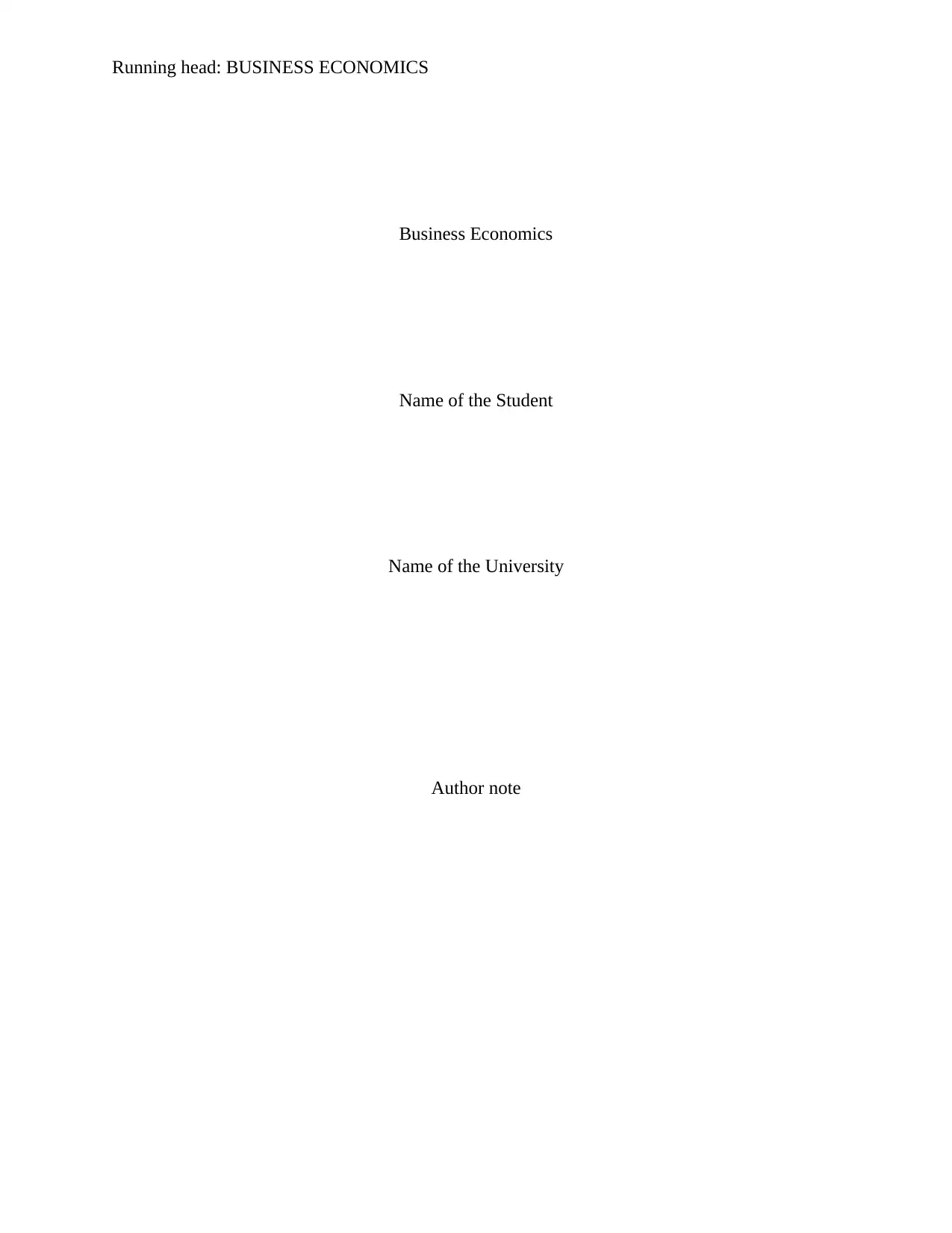
Running head: BUSINESS ECONOMICS
Business Economics
Name of the Student
Name of the University
Author note
Business Economics
Name of the Student
Name of the University
Author note
Paraphrase This Document
Need a fresh take? Get an instant paraphrase of this document with our AI Paraphraser
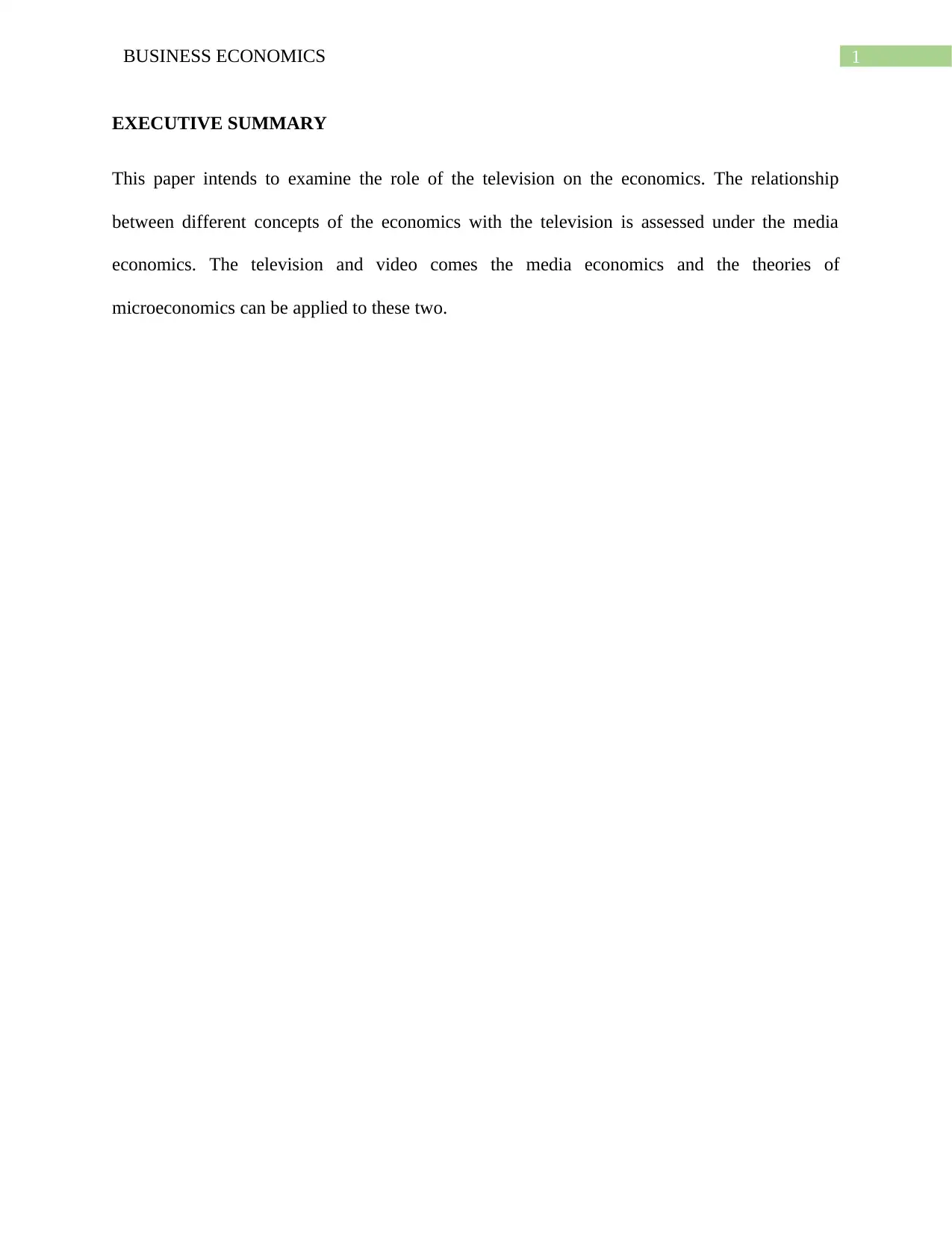
1BUSINESS ECONOMICS
EXECUTIVE SUMMARY
This paper intends to examine the role of the television on the economics. The relationship
between different concepts of the economics with the television is assessed under the media
economics. The television and video comes the media economics and the theories of
microeconomics can be applied to these two.
EXECUTIVE SUMMARY
This paper intends to examine the role of the television on the economics. The relationship
between different concepts of the economics with the television is assessed under the media
economics. The television and video comes the media economics and the theories of
microeconomics can be applied to these two.
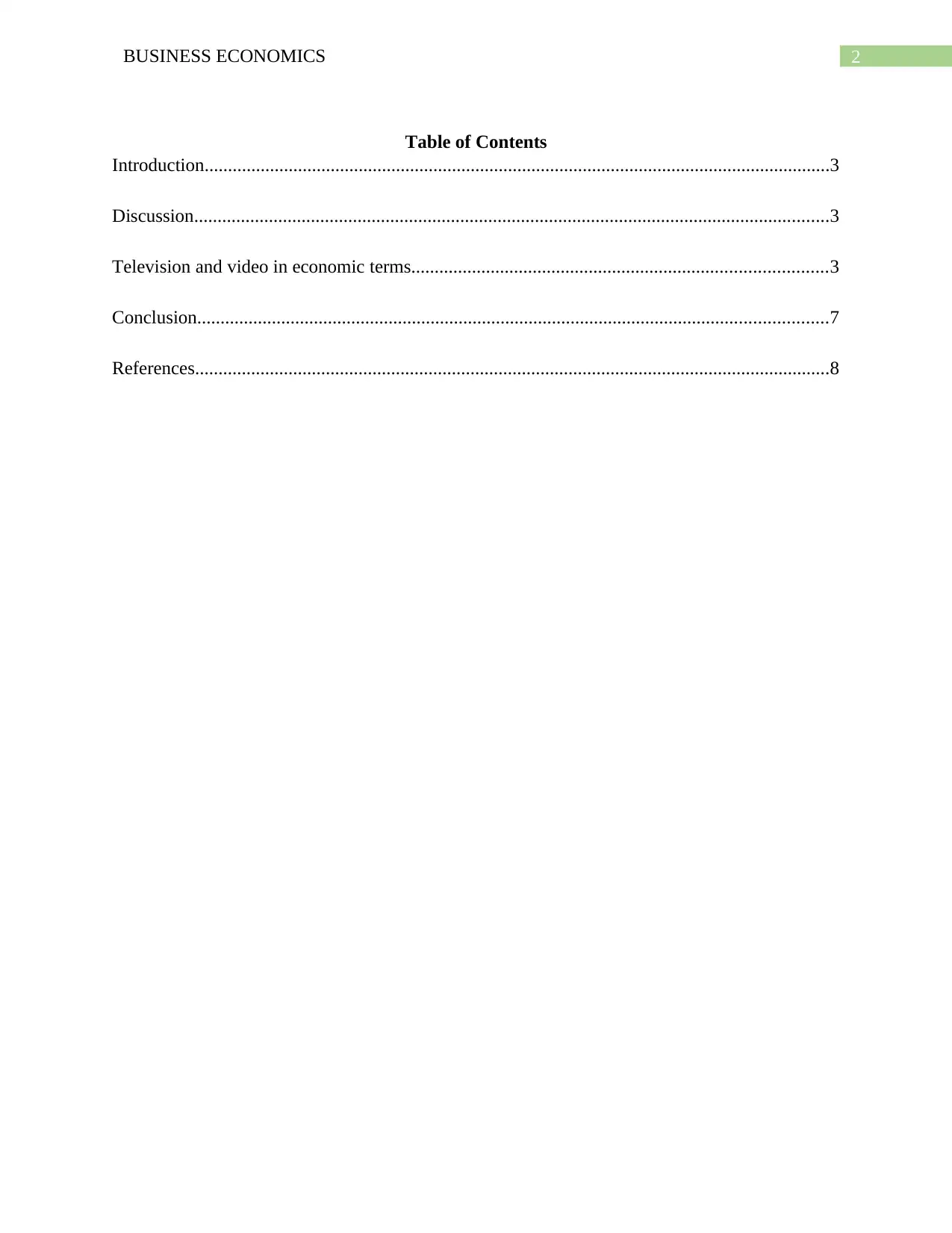
2BUSINESS ECONOMICS
Table of Contents
Introduction......................................................................................................................................3
Discussion........................................................................................................................................3
Television and video in economic terms.........................................................................................3
Conclusion.......................................................................................................................................7
References........................................................................................................................................8
Table of Contents
Introduction......................................................................................................................................3
Discussion........................................................................................................................................3
Television and video in economic terms.........................................................................................3
Conclusion.......................................................................................................................................7
References........................................................................................................................................8
⊘ This is a preview!⊘
Do you want full access?
Subscribe today to unlock all pages.

Trusted by 1+ million students worldwide
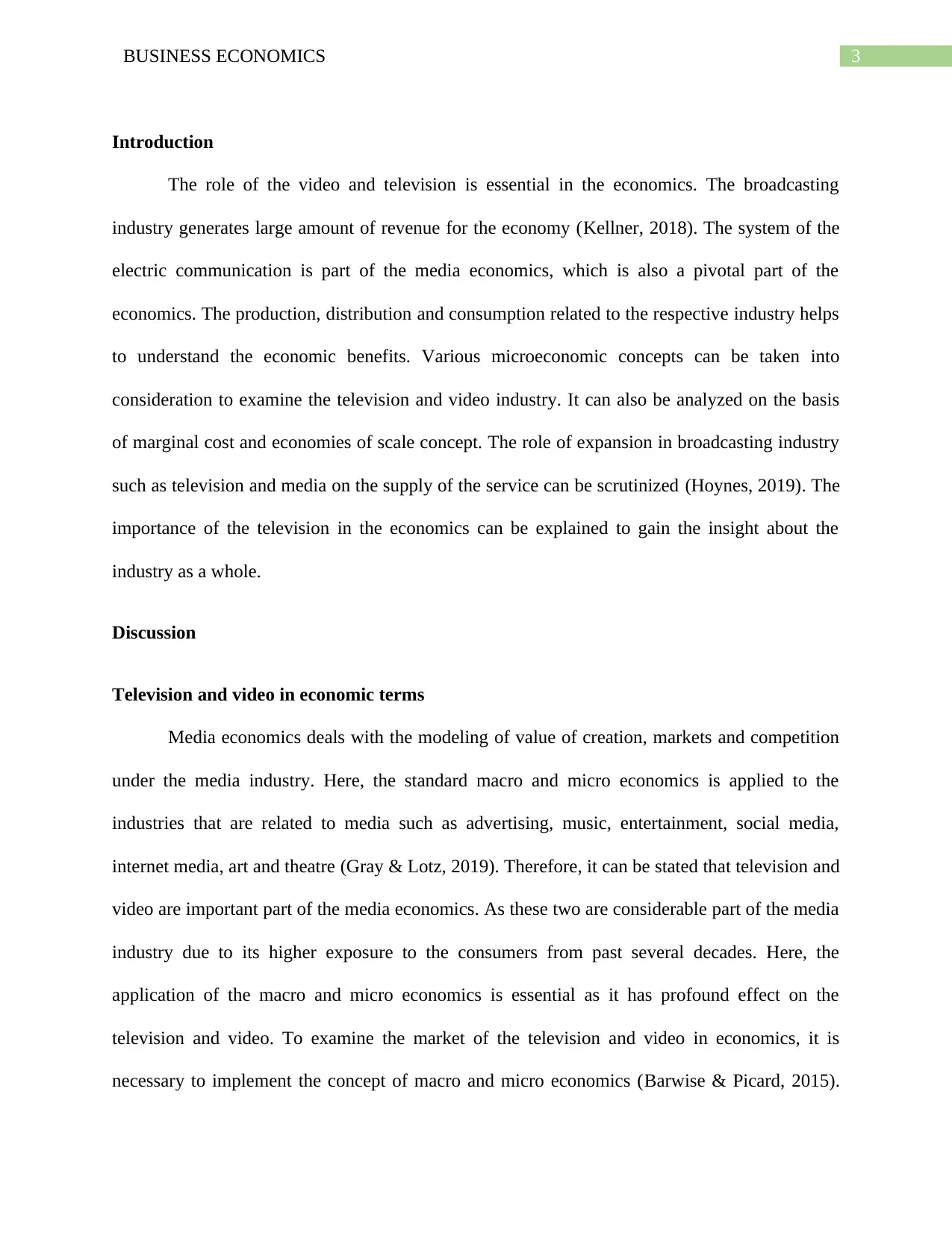
3BUSINESS ECONOMICS
Introduction
The role of the video and television is essential in the economics. The broadcasting
industry generates large amount of revenue for the economy (Kellner, 2018). The system of the
electric communication is part of the media economics, which is also a pivotal part of the
economics. The production, distribution and consumption related to the respective industry helps
to understand the economic benefits. Various microeconomic concepts can be taken into
consideration to examine the television and video industry. It can also be analyzed on the basis
of marginal cost and economies of scale concept. The role of expansion in broadcasting industry
such as television and media on the supply of the service can be scrutinized (Hoynes, 2019). The
importance of the television in the economics can be explained to gain the insight about the
industry as a whole.
Discussion
Television and video in economic terms
Media economics deals with the modeling of value of creation, markets and competition
under the media industry. Here, the standard macro and micro economics is applied to the
industries that are related to media such as advertising, music, entertainment, social media,
internet media, art and theatre (Gray & Lotz, 2019). Therefore, it can be stated that television and
video are important part of the media economics. As these two are considerable part of the media
industry due to its higher exposure to the consumers from past several decades. Here, the
application of the macro and micro economics is essential as it has profound effect on the
television and video. To examine the market of the television and video in economics, it is
necessary to implement the concept of macro and micro economics (Barwise & Picard, 2015).
Introduction
The role of the video and television is essential in the economics. The broadcasting
industry generates large amount of revenue for the economy (Kellner, 2018). The system of the
electric communication is part of the media economics, which is also a pivotal part of the
economics. The production, distribution and consumption related to the respective industry helps
to understand the economic benefits. Various microeconomic concepts can be taken into
consideration to examine the television and video industry. It can also be analyzed on the basis
of marginal cost and economies of scale concept. The role of expansion in broadcasting industry
such as television and media on the supply of the service can be scrutinized (Hoynes, 2019). The
importance of the television in the economics can be explained to gain the insight about the
industry as a whole.
Discussion
Television and video in economic terms
Media economics deals with the modeling of value of creation, markets and competition
under the media industry. Here, the standard macro and micro economics is applied to the
industries that are related to media such as advertising, music, entertainment, social media,
internet media, art and theatre (Gray & Lotz, 2019). Therefore, it can be stated that television and
video are important part of the media economics. As these two are considerable part of the media
industry due to its higher exposure to the consumers from past several decades. Here, the
application of the macro and micro economics is essential as it has profound effect on the
television and video. To examine the market of the television and video in economics, it is
necessary to implement the concept of macro and micro economics (Barwise & Picard, 2015).
Paraphrase This Document
Need a fresh take? Get an instant paraphrase of this document with our AI Paraphraser
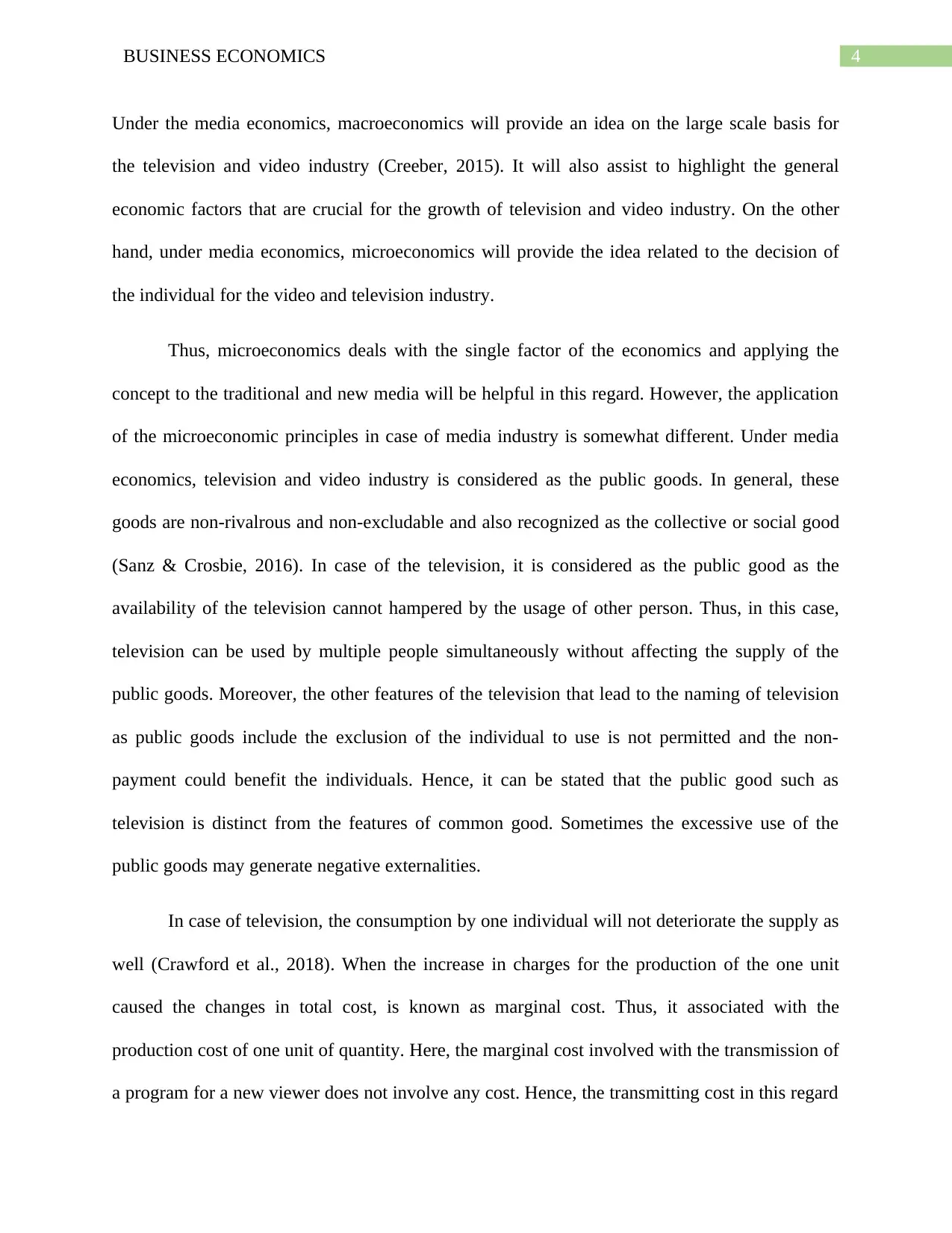
4BUSINESS ECONOMICS
Under the media economics, macroeconomics will provide an idea on the large scale basis for
the television and video industry (Creeber, 2015). It will also assist to highlight the general
economic factors that are crucial for the growth of television and video industry. On the other
hand, under media economics, microeconomics will provide the idea related to the decision of
the individual for the video and television industry.
Thus, microeconomics deals with the single factor of the economics and applying the
concept to the traditional and new media will be helpful in this regard. However, the application
of the microeconomic principles in case of media industry is somewhat different. Under media
economics, television and video industry is considered as the public goods. In general, these
goods are non-rivalrous and non-excludable and also recognized as the collective or social good
(Sanz & Crosbie, 2016). In case of the television, it is considered as the public good as the
availability of the television cannot hampered by the usage of other person. Thus, in this case,
television can be used by multiple people simultaneously without affecting the supply of the
public goods. Moreover, the other features of the television that lead to the naming of television
as public goods include the exclusion of the individual to use is not permitted and the non-
payment could benefit the individuals. Hence, it can be stated that the public good such as
television is distinct from the features of common good. Sometimes the excessive use of the
public goods may generate negative externalities.
In case of television, the consumption by one individual will not deteriorate the supply as
well (Crawford et al., 2018). When the increase in charges for the production of the one unit
caused the changes in total cost, is known as marginal cost. Thus, it associated with the
production cost of one unit of quantity. Here, the marginal cost involved with the transmission of
a program for a new viewer does not involve any cost. Hence, the transmitting cost in this regard
Under the media economics, macroeconomics will provide an idea on the large scale basis for
the television and video industry (Creeber, 2015). It will also assist to highlight the general
economic factors that are crucial for the growth of television and video industry. On the other
hand, under media economics, microeconomics will provide the idea related to the decision of
the individual for the video and television industry.
Thus, microeconomics deals with the single factor of the economics and applying the
concept to the traditional and new media will be helpful in this regard. However, the application
of the microeconomic principles in case of media industry is somewhat different. Under media
economics, television and video industry is considered as the public goods. In general, these
goods are non-rivalrous and non-excludable and also recognized as the collective or social good
(Sanz & Crosbie, 2016). In case of the television, it is considered as the public good as the
availability of the television cannot hampered by the usage of other person. Thus, in this case,
television can be used by multiple people simultaneously without affecting the supply of the
public goods. Moreover, the other features of the television that lead to the naming of television
as public goods include the exclusion of the individual to use is not permitted and the non-
payment could benefit the individuals. Hence, it can be stated that the public good such as
television is distinct from the features of common good. Sometimes the excessive use of the
public goods may generate negative externalities.
In case of television, the consumption by one individual will not deteriorate the supply as
well (Crawford et al., 2018). When the increase in charges for the production of the one unit
caused the changes in total cost, is known as marginal cost. Thus, it associated with the
production cost of one unit of quantity. Here, the marginal cost involved with the transmission of
a program for a new viewer does not involve any cost. Hence, the transmitting cost in this regard
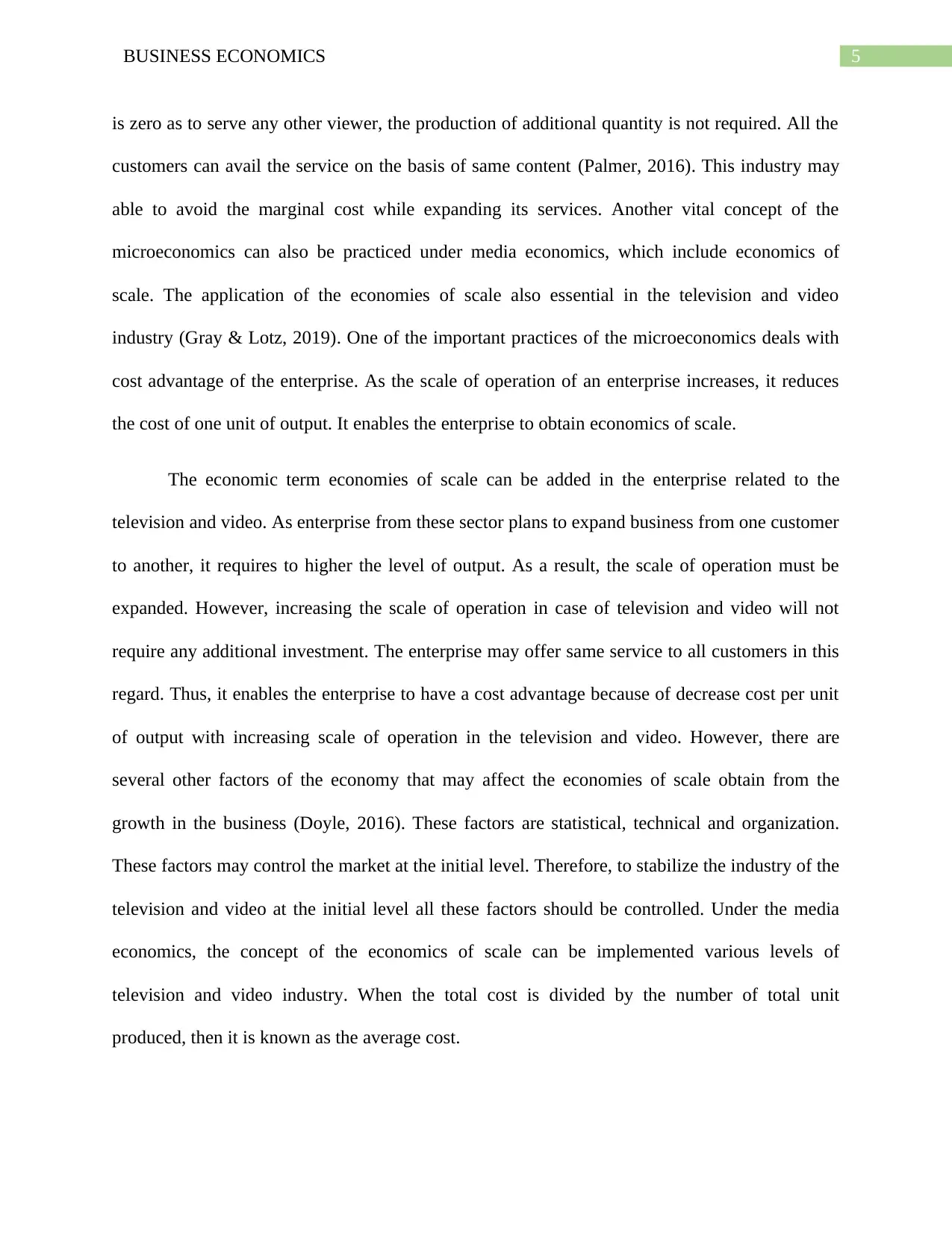
5BUSINESS ECONOMICS
is zero as to serve any other viewer, the production of additional quantity is not required. All the
customers can avail the service on the basis of same content (Palmer, 2016). This industry may
able to avoid the marginal cost while expanding its services. Another vital concept of the
microeconomics can also be practiced under media economics, which include economics of
scale. The application of the economies of scale also essential in the television and video
industry (Gray & Lotz, 2019). One of the important practices of the microeconomics deals with
cost advantage of the enterprise. As the scale of operation of an enterprise increases, it reduces
the cost of one unit of output. It enables the enterprise to obtain economics of scale.
The economic term economies of scale can be added in the enterprise related to the
television and video. As enterprise from these sector plans to expand business from one customer
to another, it requires to higher the level of output. As a result, the scale of operation must be
expanded. However, increasing the scale of operation in case of television and video will not
require any additional investment. The enterprise may offer same service to all customers in this
regard. Thus, it enables the enterprise to have a cost advantage because of decrease cost per unit
of output with increasing scale of operation in the television and video. However, there are
several other factors of the economy that may affect the economies of scale obtain from the
growth in the business (Doyle, 2016). These factors are statistical, technical and organization.
These factors may control the market at the initial level. Therefore, to stabilize the industry of the
television and video at the initial level all these factors should be controlled. Under the media
economics, the concept of the economics of scale can be implemented various levels of
television and video industry. When the total cost is divided by the number of total unit
produced, then it is known as the average cost.
is zero as to serve any other viewer, the production of additional quantity is not required. All the
customers can avail the service on the basis of same content (Palmer, 2016). This industry may
able to avoid the marginal cost while expanding its services. Another vital concept of the
microeconomics can also be practiced under media economics, which include economics of
scale. The application of the economies of scale also essential in the television and video
industry (Gray & Lotz, 2019). One of the important practices of the microeconomics deals with
cost advantage of the enterprise. As the scale of operation of an enterprise increases, it reduces
the cost of one unit of output. It enables the enterprise to obtain economics of scale.
The economic term economies of scale can be added in the enterprise related to the
television and video. As enterprise from these sector plans to expand business from one customer
to another, it requires to higher the level of output. As a result, the scale of operation must be
expanded. However, increasing the scale of operation in case of television and video will not
require any additional investment. The enterprise may offer same service to all customers in this
regard. Thus, it enables the enterprise to have a cost advantage because of decrease cost per unit
of output with increasing scale of operation in the television and video. However, there are
several other factors of the economy that may affect the economies of scale obtain from the
growth in the business (Doyle, 2016). These factors are statistical, technical and organization.
These factors may control the market at the initial level. Therefore, to stabilize the industry of the
television and video at the initial level all these factors should be controlled. Under the media
economics, the concept of the economics of scale can be implemented various levels of
television and video industry. When the total cost is divided by the number of total unit
produced, then it is known as the average cost.
⊘ This is a preview!⊘
Do you want full access?
Subscribe today to unlock all pages.

Trusted by 1+ million students worldwide
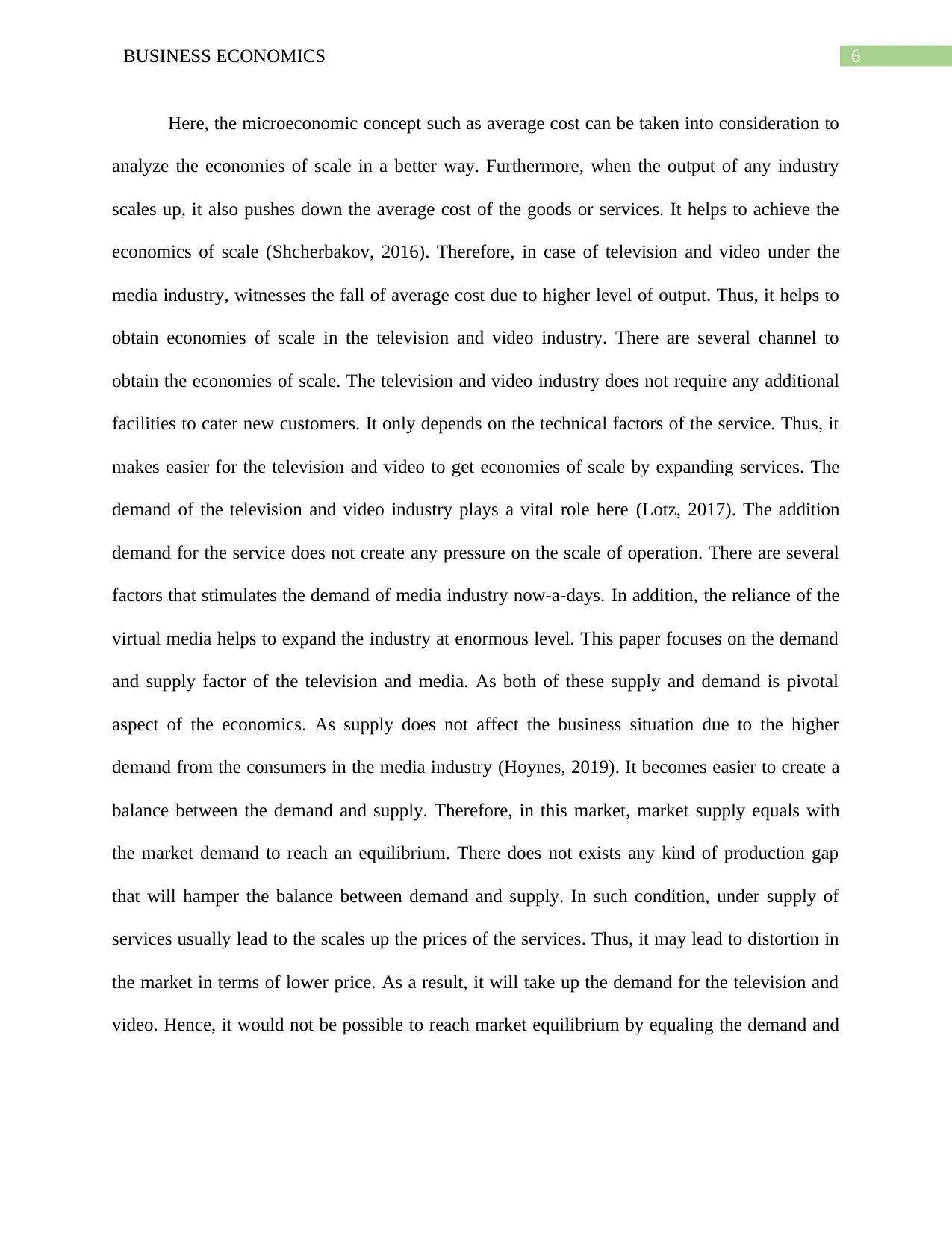
6BUSINESS ECONOMICS
Here, the microeconomic concept such as average cost can be taken into consideration to
analyze the economies of scale in a better way. Furthermore, when the output of any industry
scales up, it also pushes down the average cost of the goods or services. It helps to achieve the
economics of scale (Shcherbakov, 2016). Therefore, in case of television and video under the
media industry, witnesses the fall of average cost due to higher level of output. Thus, it helps to
obtain economies of scale in the television and video industry. There are several channel to
obtain the economies of scale. The television and video industry does not require any additional
facilities to cater new customers. It only depends on the technical factors of the service. Thus, it
makes easier for the television and video to get economies of scale by expanding services. The
demand of the television and video industry plays a vital role here (Lotz, 2017). The addition
demand for the service does not create any pressure on the scale of operation. There are several
factors that stimulates the demand of media industry now-a-days. In addition, the reliance of the
virtual media helps to expand the industry at enormous level. This paper focuses on the demand
and supply factor of the television and media. As both of these supply and demand is pivotal
aspect of the economics. As supply does not affect the business situation due to the higher
demand from the consumers in the media industry (Hoynes, 2019). It becomes easier to create a
balance between the demand and supply. Therefore, in this market, market supply equals with
the market demand to reach an equilibrium. There does not exists any kind of production gap
that will hamper the balance between demand and supply. In such condition, under supply of
services usually lead to the scales up the prices of the services. Thus, it may lead to distortion in
the market in terms of lower price. As a result, it will take up the demand for the television and
video. Hence, it would not be possible to reach market equilibrium by equaling the demand and
Here, the microeconomic concept such as average cost can be taken into consideration to
analyze the economies of scale in a better way. Furthermore, when the output of any industry
scales up, it also pushes down the average cost of the goods or services. It helps to achieve the
economics of scale (Shcherbakov, 2016). Therefore, in case of television and video under the
media industry, witnesses the fall of average cost due to higher level of output. Thus, it helps to
obtain economies of scale in the television and video industry. There are several channel to
obtain the economies of scale. The television and video industry does not require any additional
facilities to cater new customers. It only depends on the technical factors of the service. Thus, it
makes easier for the television and video to get economies of scale by expanding services. The
demand of the television and video industry plays a vital role here (Lotz, 2017). The addition
demand for the service does not create any pressure on the scale of operation. There are several
factors that stimulates the demand of media industry now-a-days. In addition, the reliance of the
virtual media helps to expand the industry at enormous level. This paper focuses on the demand
and supply factor of the television and media. As both of these supply and demand is pivotal
aspect of the economics. As supply does not affect the business situation due to the higher
demand from the consumers in the media industry (Hoynes, 2019). It becomes easier to create a
balance between the demand and supply. Therefore, in this market, market supply equals with
the market demand to reach an equilibrium. There does not exists any kind of production gap
that will hamper the balance between demand and supply. In such condition, under supply of
services usually lead to the scales up the prices of the services. Thus, it may lead to distortion in
the market in terms of lower price. As a result, it will take up the demand for the television and
video. Hence, it would not be possible to reach market equilibrium by equaling the demand and
Paraphrase This Document
Need a fresh take? Get an instant paraphrase of this document with our AI Paraphraser
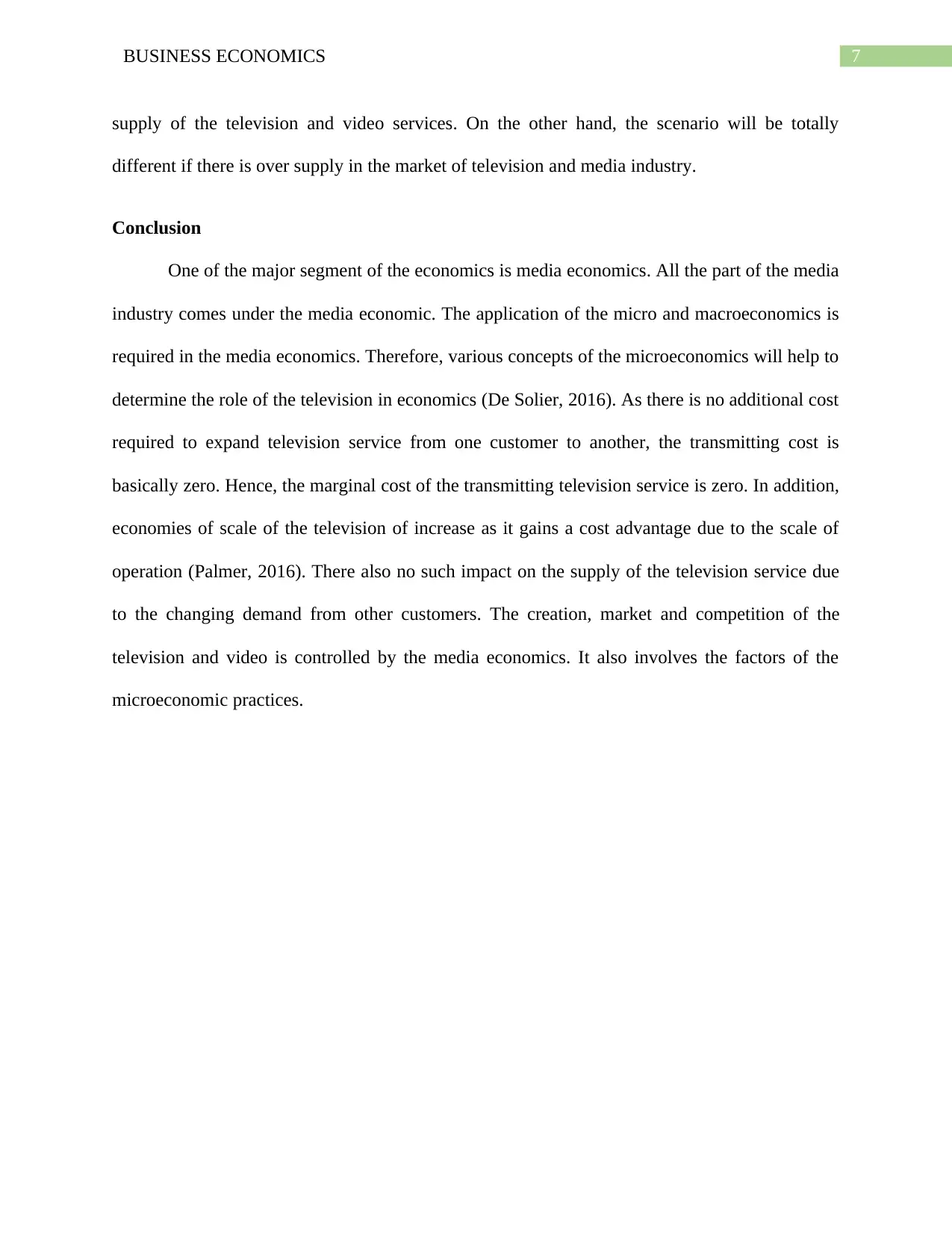
7BUSINESS ECONOMICS
supply of the television and video services. On the other hand, the scenario will be totally
different if there is over supply in the market of television and media industry.
Conclusion
One of the major segment of the economics is media economics. All the part of the media
industry comes under the media economic. The application of the micro and macroeconomics is
required in the media economics. Therefore, various concepts of the microeconomics will help to
determine the role of the television in economics (De Solier, 2016). As there is no additional cost
required to expand television service from one customer to another, the transmitting cost is
basically zero. Hence, the marginal cost of the transmitting television service is zero. In addition,
economies of scale of the television of increase as it gains a cost advantage due to the scale of
operation (Palmer, 2016). There also no such impact on the supply of the television service due
to the changing demand from other customers. The creation, market and competition of the
television and video is controlled by the media economics. It also involves the factors of the
microeconomic practices.
supply of the television and video services. On the other hand, the scenario will be totally
different if there is over supply in the market of television and media industry.
Conclusion
One of the major segment of the economics is media economics. All the part of the media
industry comes under the media economic. The application of the micro and macroeconomics is
required in the media economics. Therefore, various concepts of the microeconomics will help to
determine the role of the television in economics (De Solier, 2016). As there is no additional cost
required to expand television service from one customer to another, the transmitting cost is
basically zero. Hence, the marginal cost of the transmitting television service is zero. In addition,
economies of scale of the television of increase as it gains a cost advantage due to the scale of
operation (Palmer, 2016). There also no such impact on the supply of the television service due
to the changing demand from other customers. The creation, market and competition of the
television and video is controlled by the media economics. It also involves the factors of the
microeconomic practices.
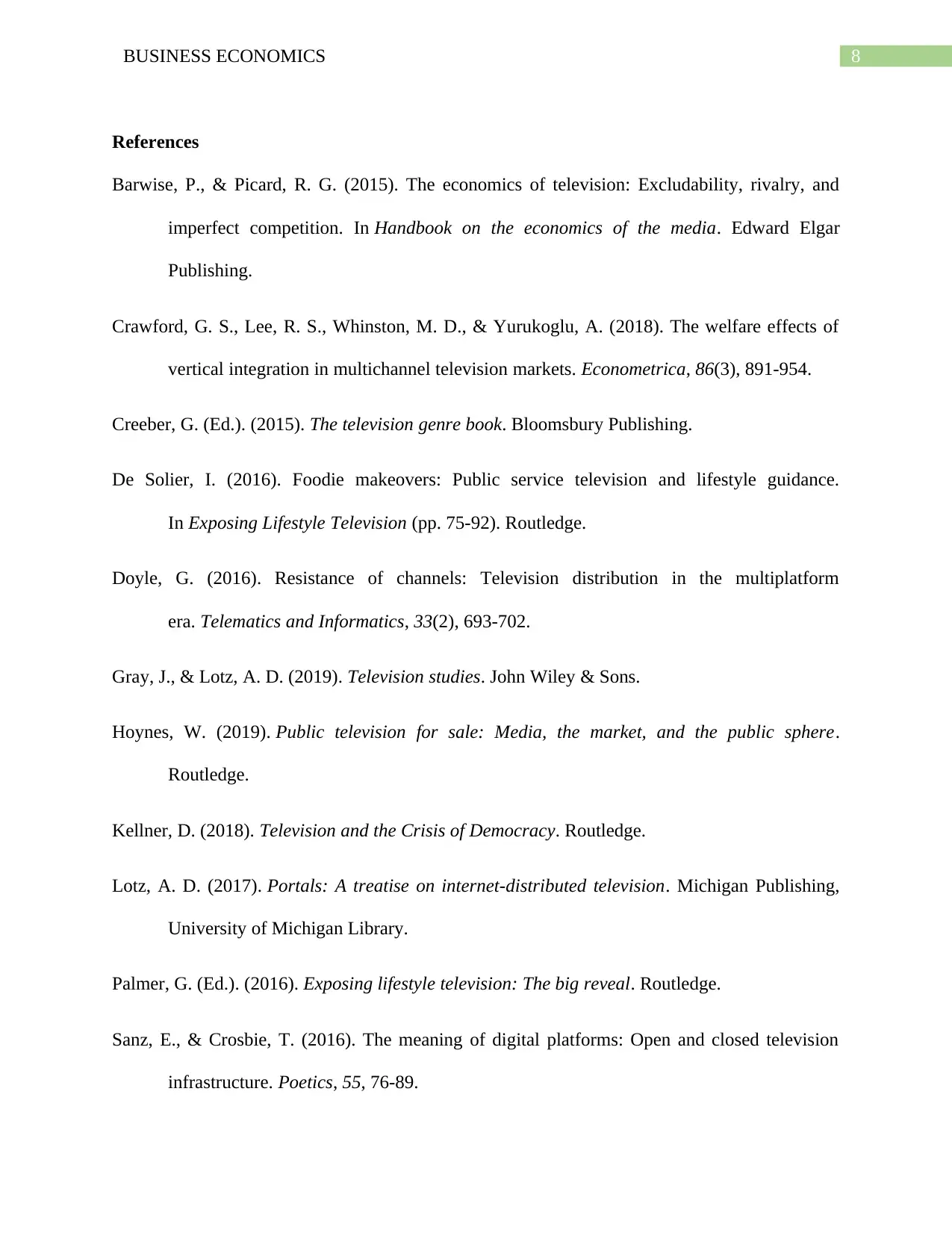
8BUSINESS ECONOMICS
References
Barwise, P., & Picard, R. G. (2015). The economics of television: Excludability, rivalry, and
imperfect competition. In Handbook on the economics of the media. Edward Elgar
Publishing.
Crawford, G. S., Lee, R. S., Whinston, M. D., & Yurukoglu, A. (2018). The welfare effects of
vertical integration in multichannel television markets. Econometrica, 86(3), 891-954.
Creeber, G. (Ed.). (2015). The television genre book. Bloomsbury Publishing.
De Solier, I. (2016). Foodie makeovers: Public service television and lifestyle guidance.
In Exposing Lifestyle Television (pp. 75-92). Routledge.
Doyle, G. (2016). Resistance of channels: Television distribution in the multiplatform
era. Telematics and Informatics, 33(2), 693-702.
Gray, J., & Lotz, A. D. (2019). Television studies. John Wiley & Sons.
Hoynes, W. (2019). Public television for sale: Media, the market, and the public sphere.
Routledge.
Kellner, D. (2018). Television and the Crisis of Democracy. Routledge.
Lotz, A. D. (2017). Portals: A treatise on internet-distributed television. Michigan Publishing,
University of Michigan Library.
Palmer, G. (Ed.). (2016). Exposing lifestyle television: The big reveal. Routledge.
Sanz, E., & Crosbie, T. (2016). The meaning of digital platforms: Open and closed television
infrastructure. Poetics, 55, 76-89.
References
Barwise, P., & Picard, R. G. (2015). The economics of television: Excludability, rivalry, and
imperfect competition. In Handbook on the economics of the media. Edward Elgar
Publishing.
Crawford, G. S., Lee, R. S., Whinston, M. D., & Yurukoglu, A. (2018). The welfare effects of
vertical integration in multichannel television markets. Econometrica, 86(3), 891-954.
Creeber, G. (Ed.). (2015). The television genre book. Bloomsbury Publishing.
De Solier, I. (2016). Foodie makeovers: Public service television and lifestyle guidance.
In Exposing Lifestyle Television (pp. 75-92). Routledge.
Doyle, G. (2016). Resistance of channels: Television distribution in the multiplatform
era. Telematics and Informatics, 33(2), 693-702.
Gray, J., & Lotz, A. D. (2019). Television studies. John Wiley & Sons.
Hoynes, W. (2019). Public television for sale: Media, the market, and the public sphere.
Routledge.
Kellner, D. (2018). Television and the Crisis of Democracy. Routledge.
Lotz, A. D. (2017). Portals: A treatise on internet-distributed television. Michigan Publishing,
University of Michigan Library.
Palmer, G. (Ed.). (2016). Exposing lifestyle television: The big reveal. Routledge.
Sanz, E., & Crosbie, T. (2016). The meaning of digital platforms: Open and closed television
infrastructure. Poetics, 55, 76-89.
⊘ This is a preview!⊘
Do you want full access?
Subscribe today to unlock all pages.

Trusted by 1+ million students worldwide

9BUSINESS ECONOMICS
Shcherbakov, O. (2016). Measuring consumer switching costs in the television industry. The
RAND Journal of Economics, 47(2), 366-393.
Shcherbakov, O. (2016). Measuring consumer switching costs in the television industry. The
RAND Journal of Economics, 47(2), 366-393.
1 out of 10
Related Documents
Your All-in-One AI-Powered Toolkit for Academic Success.
+13062052269
info@desklib.com
Available 24*7 on WhatsApp / Email
![[object Object]](/_next/static/media/star-bottom.7253800d.svg)
Unlock your academic potential
Copyright © 2020–2025 A2Z Services. All Rights Reserved. Developed and managed by ZUCOL.




